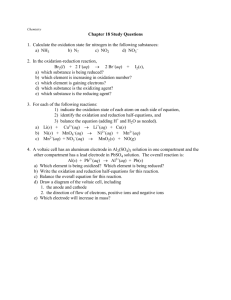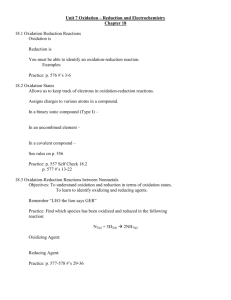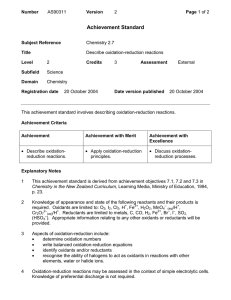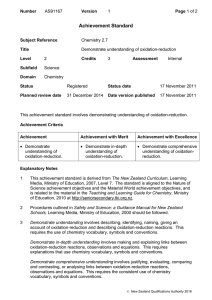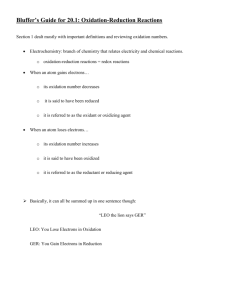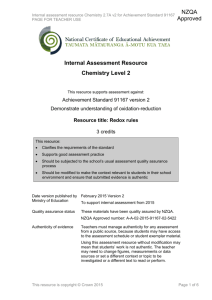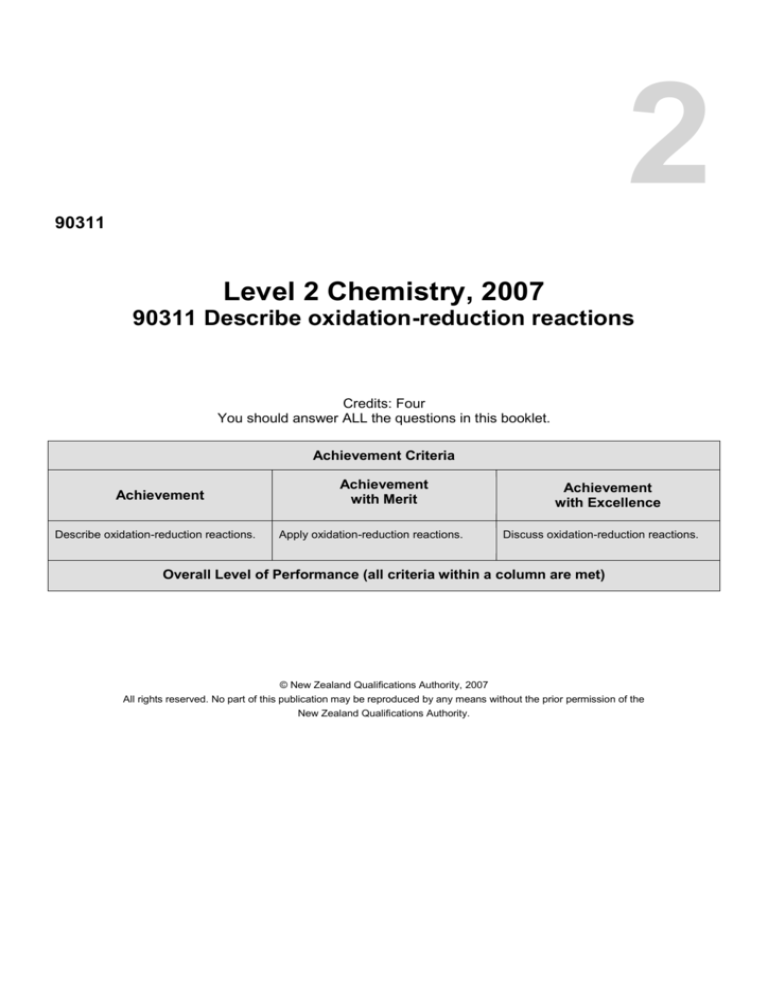
2
90311
Level 2 Chemistry, 2007
90311 Describe oxidation-reduction reactions
Credits: Four
You should answer ALL the questions in this booklet.
Achievement Criteria
Achievement
Describe oxidation-reduction reactions.
Achievement
with Merit
Apply oxidation-reduction reactions.
Achievement
with Excellence
Discuss oxidation-reduction reactions.
Overall Level of Performance (all criteria within a column are met)
© New Zealand Qualifications Authority, 2007
All rights reserved. No part of this publication may be reproduced by any means without the prior permission of the
New Zealand Qualifications Authority.
You are advised to spend 35 minutes answering the questions in this booklet.
QUESTION ONE
When sulfur dioxide gas is bubbled through a solution of acidified potassium dichromate, a colour change from
orange to green is observed.
Cr2O72– + SO2 → Cr3+ + SO42–
Unbalanced equation:
(a)
(b)
Identify the species responsible for:
(i)
the orange colour
(ii)
the green colour.
Identify the oxidant:
Use oxidation numbers to justify your answer.
QUESTION TWO
One of the following reactions is an oxidation-reduction reaction.
Reaction A
CaCO3 → CO2 + CaO
Reaction B
PbO + H2 → Pb + H2O
Reaction C
SO3 + H2O → H2SO4
Identify the oxidation-reduction reaction by circling the letter of your choice.
A
B
C
Justify your answer.
L2 Chemistry 90311, 2007 – page 2 of 8
QUESTION THREE
Describe the expected observations for each of the following oxidation-reduction reactions.
Link the observations to the species involved in the reaction.
(a)
Aqueous chlorine, Cl2(aq), is added to a solution of sodium bromide, NaBr.
(b)
A solution of iron(III) chloride, FeCl3, is added to a solution of potassium iodide, KI.
L2 Chemistry 90311, 2007 – page 3 of 8
QUESTION FOUR
(a)
(b)
Determine the oxidation number of manganese (Mn) in each of the following species.
(i)
MnO42–
(ii)
MnO2
(iii)
Mn
(iv)
MnO4–
Potassium permanganate (KMnO4) is added to iron(II) sulfate (FeSO4) under acidic conditions.
(i)
Write half-equations and the overall balanced equation for the reaction that occurs.
Oxidation half-equation
Reduction half-equation
Overall balanced equation
(ii) Describe the expected observations that you would make during this reaction and link these to reactant
and product species.
L2 Chemistry 90311, 2007 – page 4 of 8
QUESTION FIVE
Hydrogen peroxide decomposes at room temperature (25°C) according to the following equation.
2H2O2(aq) → 2H2O(ℓ) + O2(g)
The reaction involves both oxidation and reduction processes.
Discuss this statement using oxidation numbers to clearly explain why oxidation and reduction are involved in the
decomposition reaction.
Include in your answer the balanced half-equations for the processes that occur in the reaction.
L2 Chemistry 90311, 2007 – page 5 of 8
QUESTION SIX
Write balanced half-equations for the oxidation and reduction reactions occurring, and then the overall balanced
equation, for the following reaction in acidic solution.
IO3– + SO32– → I2 + SO42–
(a)
Oxidation half-equation
(b)
Reduction half-equation
(c)
Overall balanced equation
L2 Chemistry 90311, 2007 – page 6 of 8
QUESTION SEVEN
Magnesium can be produced by the electrolysis of molten magnesium chloride.
A simplified diagram of the cell used to manufacture magnesium is shown below.
(a)
Label the electrodes as anode and cathode by writing in the boxes in the diagram above.
(b)
Write half-equations for the reactions occurring at each electrode.
Cathode:
Anode:
L2 Chemistry 90311, 2007 – page 7 of 8
QUESTION EIGHT
The diagram below shows the electrolysis of molten lead bromide.
Discuss the electrolysis of molten lead bromide by linking the observations in the above cell to the reactions
occurring at the anode and cathode.
Your answer should refer to:
•
•
•
•
•
reactant and product species
movement of species
oxidation and reduction processes
anode and cathode
equations for reactions occurring.
L2 Chemistry 90311, 2007 – page 8 of 8

